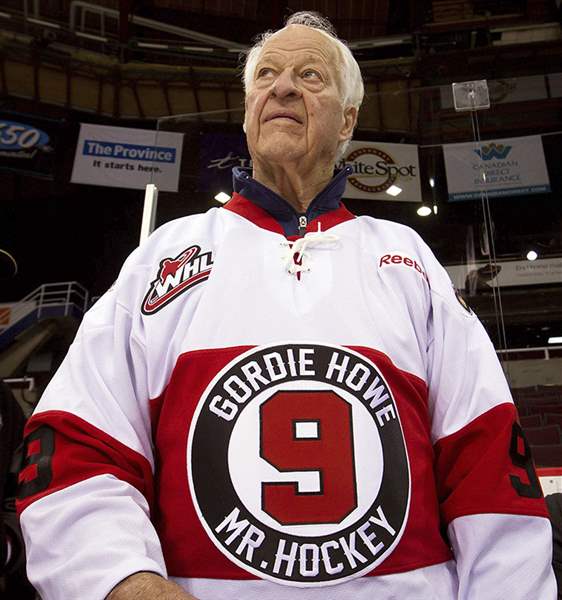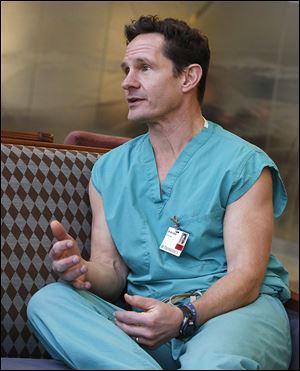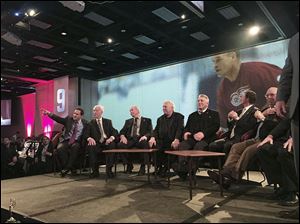
Hockey legend Gordie Howe’s recovery highlights stem-cell advances
Experimental treatment received in Mexico not yet approved in U.S.
3/1/2015
Gordie Howe, 86, suffered a stroke in October, and his family began to plan his funeral. That changed after an experimental treatment.
CANADIAN PRESS

Gordie Howe, 86, suffered a stroke in October, and his family began to plan his funeral. That changed after an experimental treatment.
Hockey legend Gordie Howe’s star power is raising awareness in the United States and Canada about advances in stem-cell therapies as he continues what is being called a “miraculous” recovery from a massive stroke.
Those closest to him, including his son, Toledo radiologist Dr. Murray Howe, are convinced the former Detroit Red Wings player would have died if he had not traveled to a medical clinic in Tijuana, Mexico, for an experimental stem-cell treatment not yet available in the United States.
After a debilitating stroke on Oct. 26, Mr. Howe, 86, had a few weeks of slight recovery, but then his health “went downhill” quickly, said Dr. Howe, director of sports medicine imaging for ProMedica Toledo Hospital. The family had started preparing for his funeral. But that all turned around after he had the adult stem-cell treatment on Dec. 8.
“If you saw him now, you wouldn’t know he had a stroke,” Dr. Howe said.
“It’s been wonderful. Every day I would say he’s a little bit better, and there are little hints of improvement. Certainly in the first month, every day his strength, coordination, and balance were better. He has been eating like a horse. He had lost 20 pounds, and now he has gained back 25 pounds, so he is pretty close to his playing weight now,” Dr. Howe said.
Amazing results
In describing his father’s treatment and recovery in the last three months, Dr. Howe does not hesitate to use words such as unbelievable, astonishing, and amazing.
Eight hours after Mr. Howe received what is called a lumbar puncture, where stem cells were injected in the spinal fluid of his lower back by an anesthesiologist, he went from being bedridden and only mumbling short sentences to speaking clearly and walking with assistance, Dr. Howe said.
On the second day at the clinic, he received an IV infusion of a different type of adult stem-cell treatment.
When he returned to his home in Lubbock, Texas, on Dec. 10, Mr. Howe’s recovery from the stroke continued at an rapid rate, his son said.
“His vocabulary had dropped down. If you showed him pictures — the speech therapists when they were testing him, he could name about one of 10 items. After his stem-cell treatments, he was able to identify 80 percent of the pictures. The speech therapist was just floored,” Dr. Howe said.
“In 28 years of medicine, I have never seen a response, a recovery, from a stroke in such a rapid time frame and such an impressive response to me that is nothing short of miraculous,” he added.
He was doing so well the family accepted an invitation for Mr. Howe to attend a dinner in his honor on Feb. 6 in his hometown of Saskatoon, Sask.
Mr. Howe played 25 seasons with the Red Wings from 1946 to 1971 and played for the Houston Aeros and the New England Whalers of the World Hockey Association from 1973 to 1979. He finished his final season in 1980 at the age of 51 with the Hartford Whalers in the organization’s first season in the NHL.
He won four Stanley Cup championships, six Hart Trophies as the NHL’s most valuable player, and six Art Ross Trophies as the NHL’s leading scorer.
At the event in Canada, Mr. Howe shared the stage with other hockey greats Wayne Gretzky and Bobby Hull. Video of the event, provided by the family, shows Mr. Howe standing under his own power for several seconds as the audience gave him a standing ovation.
“He walked on stage. He goes under his own power, but he is almost 87, and a fall risk, so I just made sure he didn’t trip,” Dr. Howe said.

Dr. Murray Howe said he was astounded at the rate of improvement his father, Gordie Howe, experienced after a stem-cell treatment at a medical center in Mexico. He said such a response was ‘nothing short of miraculous.’
Treatment in U.S.?
The lumbar injection Mr. Howe received has not been approved for use in the United States by the Food and Drug Administration partly because the clinical trial process is longer and more cautious in the United States than in some other countries, said Dr. Paula Grisanti, chairman of the National Stem Cell Foundation based in Louisville.
Each new drug or therapy must go through a phase one, phase two, and phase three trial, which can take several years and, depending on the drug, can cost millions of dollars.
Between 4,000 and 5,000 clinical trials dealing with different stem-cell drugs on the FDA website clinicaltrials.gov are in varying stages of completion in the United States and Europe, she said.
“There is a fine line we walk between regulating therapy enough to protect patients but not regulating so much to inhibit innovation,” Dr. Grisanti said.
Stem-cell research is part of a larger field of medicine that is called regenerative medicine. The field has evolved in the last 5 to 10 years and is exploding, she said.
“Every major university in the country has a stem-cell program,” Dr. Grisanti said.
The University of Toledo Medical Center, the former Medical College of Ohio, has multiple researchers looking at various aspects of stem cells but does not have a stem-cell program as such, said Jon Strunk, a university spokesman.
The IV infusion of stem cells that Mr. Howe received on the second day of treatment has been approved for use in the United States, but now patients must wait six months after a stroke to start them, Dr. Howe said.
“They are being conservative and want to see how you recover on your own in the first six months, and after that, we can attribute any improvement you have to the stem cells,” he said.
Dr. Howe does not fault the FDA for being cautious or for having regulations, but he said the result is that U.S. and Canadian doctors are at a disadvantage because other countries such as Russia have been using adult stem cells to treat a variety of illnesses for more than 20 years.
Dr. Gristani estimates it will be at least five years before the stem-cell injection used on Mr. Howe will be through all the clinical trials in the United States. Then insurance companies will have to approve their use before they become widely available, which will likely add several more years to the process.
Scientific skepticism
Because some of the treatments used on Mr. Howe are still in clinical trials here, Dr. Gristani said his recovery is being greeted with skepticism by some in the scientific community.
Most of the for-profit companies use cells manufactured from fat tissue. They take the cells from liposuction and grow them by the millions in a petri dish and manipulate them to make them more robust. They then inject them into the patient to fix the problem, Dr. Gristani said.
Some scientists, she said, are saying, “You are harvesting fat cells and injecting them, but you don’t know how long it will last because there is no clinical trial with the requirement for data collection, and how do you know, and are you protecting patients? ”
Dr. Gristani said some private companies are “leapfrogging” over the U.S. clinical trial process and offering patients treatment in other countries, such as the California-based Stemedica Cell Technologies Inc., which reached out to Mr. Howe’s family and offered him free, no-strings-attached treatment to repair the damage from his stroke.
Dr. Howe said he is aware of the critics who distrust the process. He was skeptical himself when first approached by Stemedica because he wasn’t aware of the treatment.
“Some have said, ‘Oh, it’s a placebo effect.’ Well, that doesn’t make sense because my dad, because of his short-term memory [problem], he doesn’t remember he had a stroke. He doesn’t remember he had a treatment. He has no idea. All he knows is he is doing great and doing what he likes to do,” Dr. Howe said.

From left, Dr. Murray Howe sits near his father, Gordie Howe, who is joined on stage with son Marty Howe and NHL legends such as Bobby Hull, his son Brett, who is third overall in NHL scoring, and Wayne Gretzky, at a dinner in Gordie Howe’s honor in Canada.
Stemedica’s role
Founded in 2005, Stemedica is a global biopharmaceutical company with a manufacturing capacity among the largest in the world, said Dave McGuigan, vice president of marketing and business development.
The owners are hockey fans, and Mr. McGuigan used to work for the Red Wings. Mr. Howe, he said, was very instrumental in helping him in the early days of his career at the Reds Wings organization.
When he heard about the stroke, Mr. McGuigan contacted the family and asked if they would like him to participate in one of the clinical trials the company was conducting in the United States or with their partner organization, Novastem, in Mexico, that was conducting a separate clinical trial.

Stemedica also supplies stem cells and has a partnership relationship with clinics in Indonesia and Kazakhstan, he said.
“He knew my parents. They were big Gordie Howe fans. He said, ‘We can’t promise anything, but we think we can help your dad,’ ” Dr. Howe said.
The family, including Mr. Howe’s two other sons and his daughter, felt they had nothing to lose because their dad was going downhill so fast, he said.
Stemedica connected them to the Novastem clinic. All of the stem cells and the treatment at the clinic were provided free of charge. Mr. Howe estimates his father received about $16,000 to $30,000 worth of treatment at the clinic.
Dr. Gristani said the typical cost for this type of treatment is about $25,000 to $30,000.
“It’s great PR for [Stemedica]. You may not have heard of them before, but you have now,” she said.
Dr. Howe said the company has been upfront and fair through the process and never asked him for any favors.
“They didn’t need Gordie Howe to prove the power of stem cells,” he said.
Focus on stem cells
Stemedica has received a lot of attention because of Mr. Howe’s star power, but its original intention was to do the procedure for him “discreetly,” Mr. McGuigan said. The company has only responded to media calls and has done nothing to promote his involvement, he said.
He is thrilled, however, at how Mr. Howe’s success story has elevated the discussion about what role stem cells might play in the future of medicine.
“I attribute a lot of this to Gordie because he is Mr. Hockey,” Mr. McGuigan said.
Added Dr. Howe: “You can take a negative perspective and say, well, these guys just did this for the publicity, but look at it from the opposite way. They had a lot to lose. If my dad had went there and died or got no response after dragging Gordie Howe across the country when he’s on his death bed — I mean, to me I was really impressed by that confidence.”
Dr. Howe said the company has extended another offer for his father to go back to the same clinic in June for an additional treatment that could possibly help with some of the underlying brain injuries that he suffers from playing hockey for 32 years — many of them without a helmet.
The results of the clinical trial in which Mr. Howe participated, involving about 30 to 50 patients in Mexico, will be officially published in mid-2016, Mr. McGuigan said.
Contact Marlene Harris-Taylor at mtaylor@theblade.com or 419-724-6091.